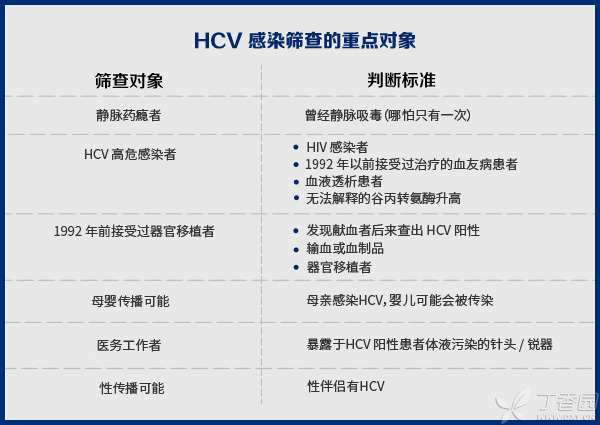
We must have heard of hepatitis, and we have also heard of it. China is a [big country with hepatitis B]. However, what we do not know is that in the hepatitis family, according to the order of Party a, Party B, Party C and Party D, there is a [hidden killer], which is the [brother] of hepatitis B virus-hepatitis C virus.
Viral hepatitis caused by hepatitis C virus (HCV) infection is called hepatitis C virus, abbreviated as [hepatitis C] or [hepatitis C]. Because hepatitis C has a large and frequently-occurring disease hidden and has almost no symptoms, it is not as [concerned] as hepatitis B.
A survey on hepatitis C awareness initiated by the China Hepatitis Prevention Foundation in 2007 showed that only 1% of the people had a correct understanding of the transmission route and preventive measures of hepatitis C; Only 5% of the respondents have been screened for hepatitis C virus.
But the disease is very dangerous.
Currently, there are about 160 million HCV infections worldwide, It causes 250,000 deaths every year. China’s epidemiological survey data show that there are about 40 million hepatitis C patients in the country, 3.2 people are infected by hepatitis C virus for every 100 people in the population, and more than 100,000 people are newly infected every year. Hepatitis C is mainly transmitted through blood transfusion, acupuncture, drug abuse, etc. Some patients can develop liver cirrhosis or even liver cancer.
In order to help readers understand hepatitis C, this article will introduce the common misunderstanding, clinical diagnosis methods and the latest treatment progress of hepatitis C.
1. Hepatitis C: A hidden killer of the liver
Hidden, asymptomatic:
After infection with HCV, patients generally do not show any symptoms. Moreover, the degree of chronic infection is very high, and less than 20% of patients can remove the virus spontaneously. Without treatment, HCV will exist in most patients for life.
To progress quietly:
Chronic hepatitis C progresses quietly and slowly, About 10% ~ 20% of patients develop liver cirrhosis within 20 years. Once progressing to liver cirrhosis, the 5-year survival rate of patients will drop to 50%, that is, half of the patients will die of hepatitis C cirrhosis every 5 years. The annual incidence rate of liver cancer in patients with hepatitis C cirrhosis is as high as 1% ~ 4%, that is to say, 1 ~ 4 people in every 100 patients with hepatitis C cirrhosis will develop liver cancer every year.
It was too late to discover:
Once hepatitis C patients have symptoms, they often progress to liver cirrhosis or even liver cancer. Therefore, compared with hepatitis of other causes, hepatitis C must not be detected by symptoms alone, but early screening should be emphasized.

2. Who needs to be screened for hepatitis C
Blood Donation:
Hepatitis C was once mainly transmitted through blood transfusion. Since 1993, when blood donors were screened for anti-HCV in China, this route has been effectively controlled.
Intravenous drug use:
At present, transmission through damaged skin and mucous membrane has become the most important mode of transmission. Among them, intravenous drug injection is the most common cause of HCV transmission. The use of non-disposable syringes and needles, dental instruments without strict disinfection, endoscopes, invasive procedures and acupuncture are also important ways of blood transmission. Some traditional medical methods (such as acupuncture) that may lead to skin damage and blood exposure are also related to HCV transmission. Sharing shavers, toothbrushes, tattoos and piercing earring holes are also potential transmission modes of HCV.
Sex:
Those who have sexual intercourse with HCV infected persons and have sexual promiscuity have a higher risk of infection, while those accompanied by other sexually transmitted diseases, especially those infected with human immunodeficiency virus, have a higher risk of infection with HCV.
Mother-to-child transmission:
Mothers infected with HCV can also infect newborns during childbirth.
Therefore, the high-risk groups that need screening can be simply summarized into the following table.

3. New drugs make hepatitis C a [curable disease]
In the past, the standard treatment plan for hepatitis C can cure more than 50% ~ 60% of hepatitis C patients, but the drug used in this standard treatment plan is an interferon, which has many side effects, making it difficult for many patients to complete the treatment course.
In addition, if you encounter patients who have progressed to liver cirrhosis, interferon is forbidden to be used for such patients. As a result, a large number of hepatitis C patients who have progressed to liver cirrhosis have lost their treatment opportunities.
At present, European and American countries have listed a drug that can directly resist viruses.
This new drug is specially responsible for disrupting the replication process of the virus. If the replication of the virus requires the synthesis of proteins, this drug directly inhibits the protease of HCV. The genetic material of the virus needs to be polymerized together to be effective, and the drug also inhibits the RNA (genetic material of the virus) polymerase of the virus.
In short, by preventing the virus from replicating smoothly, the cure rate has increased to more than 95%, thus hepatitis C has become a disease that can be cured completely.
Compared with the traditional treatment scheme, these new drugs have less side effects and can also be used for antiviral treatment of patients with hepatitis C cirrhosis.
It is very gratifying that this new anti-HCV drug has already carried out Phase III clinical trials in our country, and its official listing is just around the corner.
4. Hepatitis C patients with normal liver function also need treatment.
The reason why this disease is called “double-sided killer” is not only because it is hidden and dangerous, but also because it has the hope of cure at present.
Because of this, unlike the so-called [healthy] carriers with normal liver function in hepatitis B who do not need immediate treatment, hepatitis C has a wider choice of treatment population. As long as hepatitis C virus nucleic acid (HCV RNA) tests positive and proves to be infected by this virus, it should be actively treated.
Responsible Editor: Cat Capricorn
This article is exclusively authorized to be used by Clove Garden and refuses any other form of reprinting.
Source: Shutterstock.com
